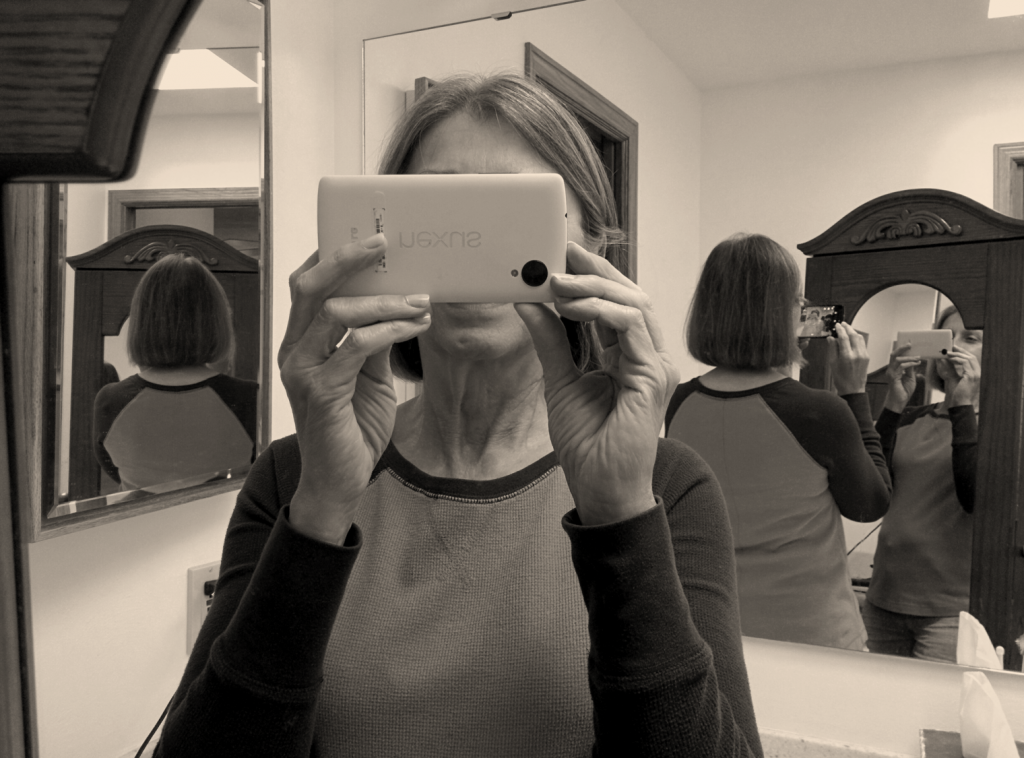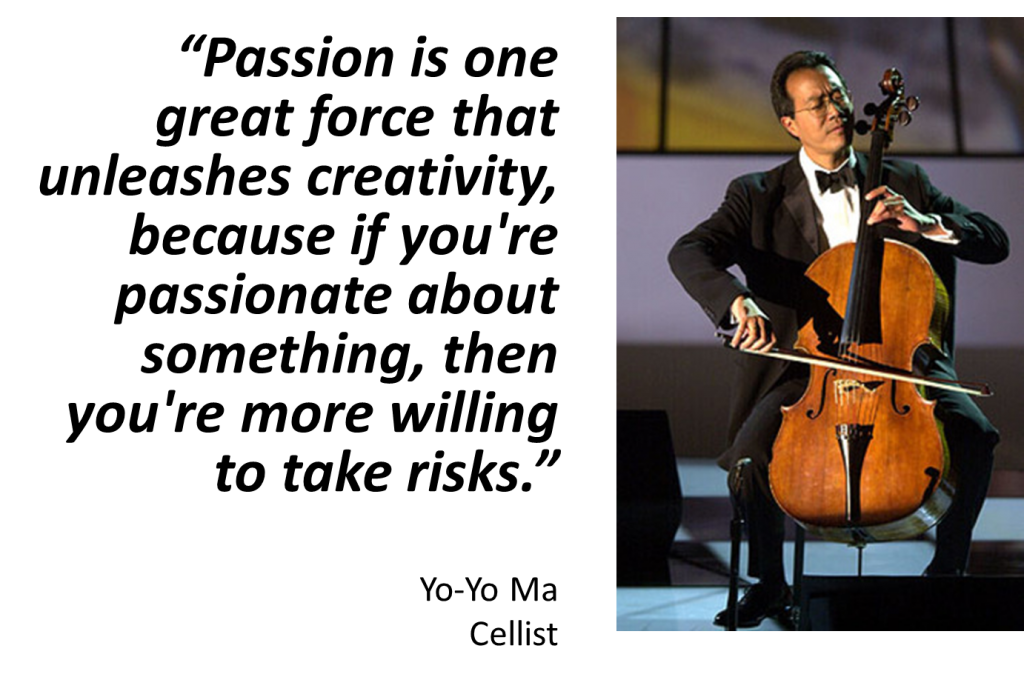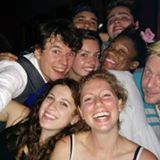(Introspecrion is the 7th of a 9-part series on creativity traits.)
Curious: passionate for fresh knowledge; desiring to learn new things
Resilient: capable of overcoming setbacks; able to take risks; ambitious
Evaluative: willing to experiment and evolve your creativity beyond the idea stage
Autonomous: independent; norm-doubting
Tuned in: open and alert to the world around you; highly perceptive
Introspective: driven by innate (intrinsic) rewards; self-accepting
Visionary: having dreams and aspirations; original thinking
Energetic: adept at managing and recharging your energy
 In prior posts I discussed curiosity and the freedom to explore and evolve creative ideas.
In prior posts I discussed curiosity and the freedom to explore and evolve creative ideas.
But none of that matters if you don’t care. If you don’t have passion. Finding your passion requires introspection into what makes you enthusiastic. Once you understand that, you are better able to self-motivate with intrinsic rewards.
That’s what this blog post is about. Creative passion. Introspection. And intrinsic motivations.
Creative passion
I have two distinct millennial daughters. The oldest is a zoo keeper (beach photo) and the youngest (smiling faces photo) is a tech project manager. They share a lot of the same genes and had a similar upbringing. But they have different interests and abilities. Very different.
Scott Barry Kaufman raises an interesting point in his Psychology Today article, Genius, Genes and Gusto: How Passions Find You. “Between 22 and 36 percent of the differences in creative achievement in the arts and sciences may be explained by natural endowment.” That means a lot of creative passion is due to things other than genetics.
Creative passion refers an extreme desire. It’s a hunger or a craving to have or do something. According to Malini Mohana in PsychCentral’s The Motivated Mind: Where Our Passion & Creativity Comes From:
“The word itself, ‘passion,’ derives from the Latin root ‘pati’ — which means ‘to suffer.’ The veracity in this linguistic statement lies in the fact that passion is what moves you to persevere at something despite fear, unhappiness or pain. It is the determination and motivation to push through suffering for the sake of an end goal.”
It’s interesting to note that passion is derived from the word for suffer. I remember my mother frequently saying, “no pains, no gains; no sacrifices, no rewards.” I learned a lot of things by living that motto during my career. Creativity may require pain and sacrifice. And occasionally the need to take risks. That’s all part of creative passion.
As cellist Yo-Yo Ma stated, “Passion is one great force that unleashes creativity, because if you’re passionate about something, then you’re more willing to take risks.”
 Introspection: Finding your Creative Passion
Introspection: Finding your Creative Passion
Creative passion fuels creativity. But have you taken the time to discover your own passion? Some people are spontaneously passionate. Others need to work to find their passions. That’s where introspection comes in.
According to Wikipedia, introspection is the examination of your thoughts and feelings. But it’s more than simply “knowing thyself” (which can, in fact, have a negative effect on mental well-being). Healthy introspection is self-reflection with a future focus and self-acceptance. It helps you differentiate between passion and obsession. Between superficiality and substance. Unhealthy introspection is spiraling rumination about the past, with an oversized focus on limitations. It can become obsessive and superficial. While knowing your limits is necessary, it’s less helpful as a propellant for creative energy.
As Oprah Winfrey said in The Secret to Finding Your Passion, “Passion can’t be found in your head because it lives in your heart.” Actually, I believe you need both head and heart to identify your passion triggers. Here are a few starting points about being introspective for creativity.
Rethink childhood memories
Children often manifest their passions by how they play. What did you absolutely love doing while you were growing up? Drawing? Singing? Competing? Building? Something else? Try to feel the excitement, intensity and joy you had from those experiences. Tap into that buzz.
Remember when you made time fly
Think about times you’ve been completely lost in what you were doing. When you were so absorbed and immersed that you lost track of time. Mihály Csíkszentmihályi refers to this as flow, or completely focused motivation. It’s in your heart, but you need to identify it in your head.
What is it that gives you this sense of flow? Do you enjoy the process of rebuilding old cars? Or get excited supporting a social cause? Perhaps you relish solving mathematical algorithms? Do you feel a sense of accomplishment after completing a strategic plan? Are you driven more by a need for self-expression or a need to find solutions? Answer these questions thoughtfully. Creativity is more likely to happen when you are in flow.
Retrace your educational offerings
People are attracted to certain topics more than others. What attracted you to non-mandatory high school or college classes? Which company-sponsored workshops interested you? Have any events at libraries, convention centers and other local meeting places sparked your interest? Look for a theme or pattern in your interests.
Find connections in leisure activities
I really enjoy bike riding. Not racing or competing, but simply escaping my day-to-day concerns. I appreciate landscaping for the same reason. So, what’s the pattern? I realized my passion wasn’t exactly biking or gardening. While I enjoy both activities, the truth is they provided the opportunity for me to plan and organize writing ideas in my head. That was the true passion.
Make a list of your leisure activities. Consider favorite books and movies. Level of sports participation. Volunteer efforts. Is there a common denominator that highlights your creative passion?
Make room for yourself
We live in a world of continuous partial attention. Multitasking is the norm. Yet disconnecting and slowing down is valuable for finding your creative passion. In “Can 10 Minutes of Meditation Make You More Creative?” three Harvard Business Review authors explain how mindfulness meditation can help get your mojo back when you’ve lost your zeal.
Then remove distractions. Clear your desk. Mute your cell phone. Suppress the urge to check email, respond to messages or clean your garage. Train yourself to focus on the creative task for as long as possible before taking a break or shifting to non-creative work.
Next, envision your environment. Do you become more creative when you are in solitude? Or when you are surrounded by people? Are you more of a sunrise or a sunset type of person? Do you need quiet? Or does background music help you think? What kind of music? These are all introspective efforts to define your creative passion. Your personal motivators.
Passion is an intrinsic motivator
 The euphoria you get when engaged in something you find meaningful is an intrinsic motivator or reward. Passion is the fuel of creativity. Decades of research have shown that creativity increases when people are “intrinsically motivated by the interest, enjoyment, satisfaction, and challenge of the work itself.”
The euphoria you get when engaged in something you find meaningful is an intrinsic motivator or reward. Passion is the fuel of creativity. Decades of research have shown that creativity increases when people are “intrinsically motivated by the interest, enjoyment, satisfaction, and challenge of the work itself.”
Extrinsic motivation, on the other hand, refers to incentives, rewards, or penalties that are external to the individual. They are not similarly effective for stimulating creativity. In fact, people may become less creative when provided with external motivation for a task they already enjoy because they begin to externalize the motivation. Dan Pink, in his TED talk on “The Puzzle of Motivation,” provides a solid case for the value of intrinsic over extrinsic motivation for creative efforts.
You are more likely to be intrinsically self-motivated (in flow) when you are involved with a task or project you are passionate about. Even if you are not enthusiastic about every aspect of a project, look for specific parts that interest you.
Where to from here?
In addition to creative passion, part of your motivation will come from your dreams and visions, as I will discuss in the next post.


